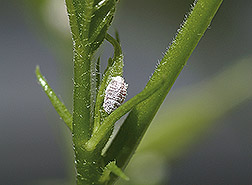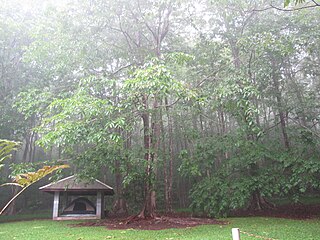
Hibiscus is a genus of flowering plants in the mallow family, Malvaceae. The genus is quite large, comprising several hundred species that are native to warm temperate, subtropical and tropical regions throughout the world. Member species are renowned for their large, showy flowers and those species are commonly known simply as "hibiscus", or less widely known as rose mallow.

Hibiscus rosa-sinensis, known colloquially as Chinese hibiscus, China rose, Hawaiian hibiscus, rose mallow and shoeblack plant, is a species of tropical hibiscus, a flowering plant in the Hibisceae tribe of the family Malvaceae. It is widely cultivated as an ornamental plant in the tropics and subtropics.
Located about 2,300 miles (3,680 km) from the nearest continental shore, the Hawaiian Islands are the most isolated group of islands on the planet. The plant and animal life of the Hawaiian archipelago is the result of early, very infrequent colonizations of arriving species and the slow evolution of those species—in isolation from the rest of the world's flora and fauna—over a period of at least 5 million years. As a consequence, Hawai'i is home to a large number of endemic species. The radiation of species described by Charles Darwin in the Galapagos Islands which was critical to the formulation of his theory of evolution is far exceeded in the more isolated Hawaiian Islands.

ʻĀinahau was the royal estate of Princess Victoria Kaʻiulani, heir to the throne of the Kingdom of Hawaiʻi.
Hawaiian hibiscus are seven species of hibiscus native to Hawaii. The yellow hibiscus is Hawaii's state flower. Most commonly grown as ornamental plants in the Hawaiian Islands are the non-native Chinese hibiscus and its numerous hybrids, though the native Hibiscus arnottianus is occasionally planted.

Thespesia populnea, commonly known as the portia tree, Pacific rosewood, Indian tulip tree, or milo, among other names, is a species of flowering plant belonging to the mallow family, Malvaceae. It is a tree found commonly on coasts around the world. Although it is confirmed to be native only to the Old World tropics, other authorities consider it to have a wider, possibly pantropical native distribution. It is thought to be an invasive species in Florida and Brazil.

Hibiscus tiliaceus, commonly known as the sea hibiscus or coast cottonwood, is a species of flowering tree in the mallow family, Malvaceae, with a pantropical distribution along coastlines. It has also been introduced to Florida and New Zealand. It has been debated whether this species is native or introduced to Hawaii.

Hibiscus waimeae is a species of flowering plant within the okra family, Malvaceae, that is endemic to the island of Kauaʻi in Hawaii.

Hibiscus clayi, common names red Kauai rosemallow, Clay's hibiscus or Kokiʻo ʻula, is a perennial angiosperm of the mallow family Malvaceae. This species has unique leaves that are round and toothed and grow in a decussate pattern.

Maconellicoccus hirsutus, is a pest of many plants, trees, and shrubs. It infests hibiscus, citrus, coffee, sugar cane, annonas, plums, guava, mango, okra, sorrel, teak, mora, pigeon pea, peanut, grapevine, maize, asparagus, chrysanthemum, beans, cotton, soybean, cocoa, and many other plants. The pest forms colonies on the host plant, and if left undisturbed, the colonies will grow into large masses of white waxy coverings on branches, fruiting structures, leaves, and even whole plants, including large trees.

Hibiscadelphus is a genus of flowering plants that are endemic to Hawaiʻi. It is known by the Native Hawaiians as hau kuahiwi which means "mountain Hibiscus". The Latin name Hibiscadelphus means "brother of Hibiscus". It is distinctive for its peculiar flowers, which do not fully open. Hibiscadelphus is in the family Malvaceae, subfamily Malvoideae. Several of the species in this small genus are presumed extinct, as a result of coextinction with their primary pollinators, the Hawaiian honeycreepers.

The Limahuli Garden and Preserve is a 17-acre botanical garden (6.9 ha) and 985-acre nature preserve (399 ha) on the north shore of Kauaʻi island, Hawaiʻi. It is one of the five gardens of the non-profit National Tropical Botanical Garden.

Hibiscus hastatus is a large shrub or tree in the family Malvaceae. H. hastatus is known by its common name of Purau teruere or Tahiti hibiscus.
Yosihiko H. Sinoto was a Japanese-born American anthropologist at the Bishop Museum in Honolulu, Hawaii. He is known for his anthropological expeditions throughout the Pacific, particularly Hawaii and French Polynesia.

The Kalōpā Native Forest State Park and Recreation Area is a state park with an arboretum of native trees located approximately 40 mi (64 km) northwest of Hilo, near the village of Honokaʻa, a few miles inland from the Mamalahoa Highway section of the Hawaii Belt Road, Island of Hawaiʻi, Hawaiʻi.

Talipariti is a genus of plants in the mallow family Malvaceae. It consists of 22 species, which are exclusively tropical except for one species whose range extends into temperate areas of Japan and Korea. Most authors now treat these species as part of the genus Hibiscus, in which case they form the section Hibiscus sect. Azanzae.

Anomis flava, the cotton looper, tropical anomis or white-pupiled scallop moth, is a moth of the family Erebidae. The species was first described by Johan Christian Fabricius in 1775. It is found in large parts of the world, including China, Hawaii, São Tomé and Príncipe, the Society Islands, Thailand, New Zealand, and Australia. Subspecies Anomis flava fimbriago is found in North America.
Anomis hawaiiensis is a moth of the family Erebidae. It was first described by Arthur Gardiner Butler in 1882. It is endemic to the Hawaiian islands of Kauai, Oahu and Hawaii.

Adoretus sinicus or the Chinese rose beetle is a scarab beetle, and a member of the genus Adoretus, subgenus Adoretus.














